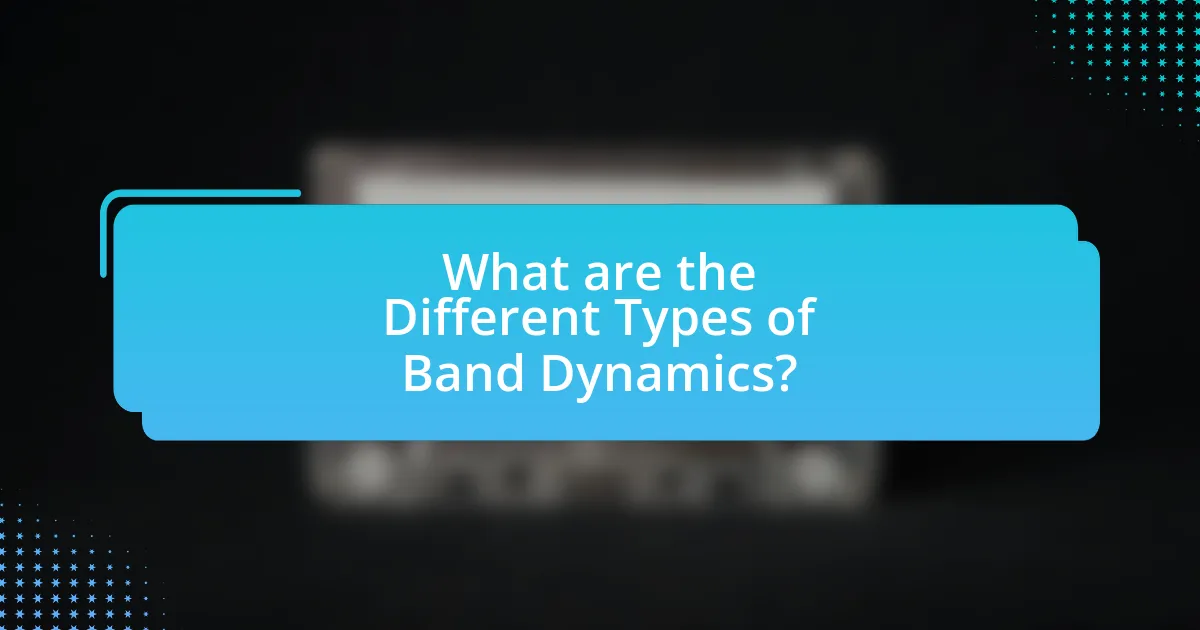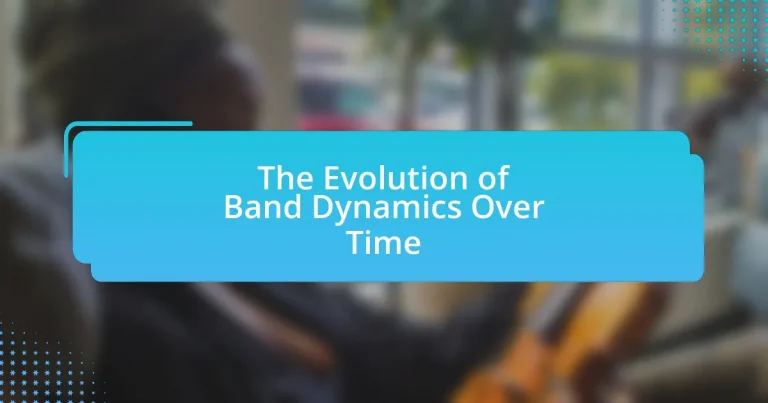The article focuses on the evolution of band dynamics over time, examining the interactions and relationships among musicians within a band and their impact on creativity, collaboration, and performance. It outlines the historical progression of band dynamics from informal collaborations to structured entities influenced by commercial interests, and now to more egalitarian arrangements facilitated by technology. Key factors influencing these changes include technological advancements, shifts in music consumption, and cultural contexts. The article also discusses the roles of individual members, the importance of communication, and strategies for maintaining healthy dynamics, highlighting how these elements contribute to a band’s overall success and adaptability in the music industry.

What are Band Dynamics and Their Importance in Music?
Band dynamics refer to the interactions and relationships among musicians within a band, influencing how they communicate, collaborate, and perform together. These dynamics are crucial in music as they affect the overall sound, creativity, and cohesion of the group. For instance, effective band dynamics can lead to innovative musical ideas and a more engaging performance, while poor dynamics may result in conflicts and a lack of synergy. Research indicates that successful bands often exhibit strong interpersonal relationships and clear communication, which enhances their ability to create and perform music collaboratively.
How have band dynamics evolved throughout music history?
Band dynamics have evolved significantly throughout music history, transitioning from collective, informal collaborations to structured, commercially driven entities. In the early 20th century, bands often consisted of small groups of musicians who played together in informal settings, such as jazz ensembles, where improvisation and individual expression were paramount. As music genres developed, particularly with the rise of rock and pop in the mid-20th century, bands began to adopt more defined roles, with clear leadership structures and specific responsibilities assigned to members, such as lead vocalist, guitarist, and drummer.
The emergence of technology and the music industry in the late 20th century further transformed band dynamics, as record labels began to exert influence over creative decisions, leading to a more commercial approach to music production. This shift often resulted in conflicts within bands, as artistic vision clashed with commercial interests. For example, the Beatles experienced significant internal tensions as they navigated their artistic evolution alongside the pressures of fame and marketability.
In recent decades, the rise of digital platforms and social media has democratized music production and distribution, allowing bands to connect directly with audiences. This has led to more collaborative and egalitarian dynamics, where members can contribute creatively without the constraints of traditional industry structures. Additionally, the prevalence of virtual collaborations has enabled musicians to form bands across geographical boundaries, further diversifying the dynamics within groups.
Overall, band dynamics have shifted from informal, collective interactions to structured roles influenced by commercial interests, and now to more collaborative and flexible arrangements facilitated by technology.
What key factors have influenced changes in band dynamics over time?
Key factors that have influenced changes in band dynamics over time include technological advancements, shifts in music consumption, and evolving cultural contexts. Technological advancements, such as the introduction of digital recording and social media platforms, have altered how bands create, distribute, and promote their music, leading to more collaborative and diverse dynamics. Shifts in music consumption, particularly the transition from physical albums to streaming services, have changed how bands engage with their audiences and manage their careers, often resulting in a greater emphasis on live performances and social media presence. Additionally, evolving cultural contexts, including changes in societal values and musical genres, have influenced the roles and relationships within bands, prompting adaptations in their dynamics to remain relevant and connected to their audiences.
How do cultural shifts impact band dynamics?
Cultural shifts significantly impact band dynamics by altering the relationships, creative processes, and public perceptions within the group. For instance, the rise of social media has transformed how bands interact with their fans and each other, fostering a more collaborative environment but also introducing pressures related to public image and online presence. Historical examples include the shift in music styles during the 1960s counterculture movement, which led to bands like The Beatles evolving their sound and approach to songwriting in response to societal changes. This illustrates that cultural contexts can dictate not only the music produced but also the internal cohesion and decision-making processes within bands.
What roles do individual members play in a band’s dynamics?
Individual members in a band play distinct roles that contribute to the overall dynamics and functionality of the group. Each member typically assumes a specific position, such as lead vocalist, guitarist, bassist, drummer, or keyboardist, which influences the band’s sound and creative direction. For example, the lead vocalist often serves as the face of the band, driving the lyrical content and engaging the audience, while the guitarist may shape the musical style through riffs and solos.
Additionally, the drummer maintains the rhythm and tempo, providing a foundation for the other instruments, and the bassist complements this by adding depth to the harmonic structure. These roles create a balance that fosters collaboration and innovation within the band. Research indicates that effective communication and role clarity among band members enhance group cohesion and performance quality, as seen in studies on musical ensembles. Thus, the interplay of individual roles is crucial for a band’s success and evolution over time.
How do member relationships affect a band’s performance?
Member relationships significantly influence a band’s performance by impacting collaboration, creativity, and overall cohesion. Strong interpersonal connections among band members foster open communication, leading to more effective collaboration during rehearsals and performances. For instance, research published in the Journal of Music Psychology indicates that bands with positive interpersonal dynamics tend to exhibit higher levels of creativity and innovation in their music, resulting in more engaging performances. Conversely, strained relationships can lead to conflicts, reduced motivation, and a lack of unity, ultimately diminishing the quality of the band’s output. Thus, the nature of member relationships directly correlates with the band’s ability to perform cohesively and effectively.
What are the common challenges faced by band members in maintaining dynamics?
Band members commonly face challenges such as communication issues, differing creative visions, and interpersonal conflicts in maintaining dynamics. Effective communication is crucial for aligning musical ideas and ensuring that all members feel heard; however, misunderstandings can lead to frustration and discord. Differing creative visions can create tension, as members may have varying opinions on the direction of the music, which can hinder collaboration. Additionally, interpersonal conflicts, often stemming from personality clashes or external pressures, can disrupt the group’s cohesion and affect overall performance. These challenges are well-documented in studies on group dynamics, highlighting the importance of clear communication and conflict resolution strategies in maintaining a harmonious band environment.
Why is understanding band dynamics crucial for aspiring musicians?
Understanding band dynamics is crucial for aspiring musicians because it directly influences collaboration, creativity, and overall group cohesion. Effective communication and interpersonal relationships within a band can enhance musical synergy, leading to more innovative and cohesive performances. Research indicates that bands with strong interpersonal dynamics often produce higher quality music and maintain longer-lasting partnerships, as evidenced by studies showing that successful bands prioritize mutual respect and understanding among members.
How can knowledge of band dynamics improve collaboration among musicians?
Knowledge of band dynamics can significantly improve collaboration among musicians by fostering better communication and understanding of individual roles within the group. When musicians are aware of the dynamics, such as leadership styles, interpersonal relationships, and conflict resolution strategies, they can navigate challenges more effectively. For instance, research by the Journal of Music Psychology indicates that bands with clear role definitions and open communication channels experience higher levels of creativity and satisfaction. This understanding allows musicians to leverage each member’s strengths, leading to a more cohesive and productive collaborative environment.
What lessons can be learned from historical band dynamics?
Historical band dynamics reveal that effective communication and collaboration are crucial for longevity and success. For instance, the Beatles’ ability to navigate personal differences and maintain open dialogue contributed to their groundbreaking creativity and sustained popularity. Conversely, the breakup of Fleetwood Mac illustrates how unresolved conflicts and lack of cohesion can lead to disbandment, despite commercial success. These examples underscore the importance of interpersonal relationships and conflict resolution in maintaining a productive group dynamic.

What are the Different Types of Band Dynamics?
The different types of band dynamics include interpersonal dynamics, creative dynamics, and performance dynamics. Interpersonal dynamics refer to the relationships and communication styles among band members, which can significantly influence collaboration and conflict resolution. Creative dynamics involve the processes through which band members generate and develop musical ideas, impacting the overall sound and direction of the music. Performance dynamics encompass the interactions and energy exchange during live performances, affecting audience engagement and the band’s cohesion on stage. These dynamics evolve over time as bands experience changes in membership, musical direction, and external influences, shaping their identity and success in the music industry.
How do different genres influence band dynamics?
Different genres significantly influence band dynamics by shaping collaboration styles, communication methods, and creative processes. For instance, in genres like jazz, improvisation is central, leading to a more fluid and spontaneous interaction among band members, which fosters a collaborative environment. In contrast, rock bands often have a more hierarchical structure, where roles are clearly defined, and decision-making may be concentrated in the hands of a lead vocalist or guitarist, impacting how members interact and contribute creatively.
Research indicates that genre-specific practices can dictate the frequency and nature of conflicts within bands; for example, a study published in the Journal of Music Psychology found that bands in genres with a strong emphasis on individual expression, such as punk, often experience more interpersonal conflicts compared to those in genres that prioritize collective harmony, like folk. This illustrates how the characteristics of a genre can directly affect the dynamics and relationships within a band.
What are the unique dynamics found in rock bands compared to jazz ensembles?
Rock bands typically exhibit a more structured and hierarchical dynamic compared to jazz ensembles, which are characterized by a more fluid and egalitarian approach. In rock bands, roles are often clearly defined, with a lead vocalist or guitarist taking center stage, while other members support through rhythm and harmony. This structure facilitates a cohesive sound and allows for the creation of anthemic songs that appeal to mass audiences. In contrast, jazz ensembles prioritize improvisation and collective creativity, where musicians often share the spotlight, leading to spontaneous interactions and a more democratic musical dialogue. This difference is evident in the performance styles, as rock bands focus on delivering polished, rehearsed sets, while jazz ensembles thrive on the unpredictability of live improvisation, allowing for unique interpretations of pieces during each performance.
How do solo artists differ from traditional band dynamics?
Solo artists operate independently, making creative decisions without the need for consensus, unlike traditional bands that rely on collaboration among multiple members. This independence allows solo artists to have complete control over their music, style, and branding, which can lead to a more cohesive artistic vision. In contrast, traditional band dynamics often involve negotiation and compromise, which can result in a diverse range of influences but may also lead to conflicts and slower decision-making processes. Historical examples include artists like Prince, who maintained creative control as a solo act, versus bands like The Beatles, whose collaborative efforts shaped their sound but also led to internal tensions.
What are the common structures of band dynamics?
Common structures of band dynamics include roles, relationships, and communication patterns among band members. Roles often consist of designated positions such as lead vocalist, guitarist, drummer, and bassist, which help define responsibilities and contributions to the group’s overall sound. Relationships within the band can vary from collaborative partnerships to competitive tensions, influencing creative output and group cohesion. Communication patterns, whether verbal or non-verbal, play a crucial role in decision-making processes and conflict resolution, impacting the band’s ability to function effectively. These structures have been observed in various studies, such as those analyzing group dynamics in musical ensembles, which highlight the importance of clear roles and effective communication for successful collaboration.
How does the size of a band affect its dynamics?
The size of a band significantly affects its dynamics by influencing the complexity of arrangements and the interaction between members. Larger bands often have more diverse instrumentation, which can create richer soundscapes and allow for intricate harmonies, as seen in orchestras or big bands. Conversely, smaller bands typically foster tighter communication and cohesion among members, leading to more spontaneous and intimate performances. Research indicates that group size impacts performance dynamics, with studies showing that smaller ensembles can adapt more quickly to changes in tempo and style, enhancing overall musical synergy.
What roles do leadership and hierarchy play in band dynamics?
Leadership and hierarchy are crucial in band dynamics as they establish roles, responsibilities, and decision-making processes within the group. Effective leadership fosters collaboration and creativity, guiding the band towards a unified vision, while a clear hierarchy helps manage conflicts and streamline communication. Research indicates that bands with defined leadership structures often experience higher levels of productivity and cohesion, as seen in successful groups like The Beatles, where John Lennon and Paul McCartney’s leadership roles significantly influenced their creative output and group dynamics.
What are the emotional dynamics within a band?
The emotional dynamics within a band are characterized by complex interactions that influence creativity, collaboration, and conflict resolution. These dynamics often stem from individual personalities, shared experiences, and the pressures of performance, which can lead to both strong bonds and tensions among members. Research indicates that emotional intelligence plays a crucial role in navigating these dynamics, as bands with higher emotional awareness tend to experience better communication and cohesion. For example, a study published in the Journal of Music Psychology found that bands with members who actively engage in emotional expression and support exhibit greater overall satisfaction and longevity.
How do personal relationships among band members influence their music?
Personal relationships among band members significantly influence their music by shaping collaboration, creativity, and emotional expression. When band members share strong personal bonds, they often communicate more openly, leading to a more cohesive sound and innovative songwriting. For instance, the Beatles’ close friendships allowed them to experiment with diverse musical styles, resulting in groundbreaking albums like “Sgt. Pepper’s Lonely Hearts Club Band.” Conversely, strained relationships can lead to conflicts that affect the music negatively, as seen in Fleetwood Mac during the recording of “Rumours,” where personal tensions fueled both creativity and discord. Thus, the dynamics of personal relationships directly impact the artistic output and overall success of a band.
What strategies can bands use to manage emotional dynamics effectively?
Bands can manage emotional dynamics effectively by implementing open communication, establishing clear roles, and fostering a supportive environment. Open communication allows band members to express their feelings and concerns, which can prevent misunderstandings and build trust. Establishing clear roles helps each member understand their responsibilities, reducing conflict and promoting collaboration. Fostering a supportive environment encourages members to share their emotional experiences, leading to stronger interpersonal relationships. Research indicates that bands with strong communication practices report higher satisfaction and lower turnover rates, demonstrating the effectiveness of these strategies in managing emotional dynamics.

How Can Bands Adapt to Changing Dynamics Over Time?
Bands can adapt to changing dynamics over time by embracing technological advancements, evolving their musical styles, and engaging with their audience through social media. For instance, the rise of digital streaming platforms has shifted how bands distribute their music, allowing them to reach wider audiences without traditional record label constraints. Additionally, bands like Radiohead have successfully experimented with different genres and innovative release strategies, demonstrating adaptability in their sound and marketing approaches. Engaging with fans on platforms like Instagram and TikTok enables bands to maintain relevance and foster a loyal fanbase, as seen with artists who leverage viral trends to promote new music. These strategies illustrate how bands can effectively navigate the evolving landscape of the music industry.
What strategies can bands implement to maintain healthy dynamics?
Bands can implement regular communication and conflict resolution strategies to maintain healthy dynamics. Open dialogue fosters trust and understanding among members, allowing them to address issues before they escalate. Research indicates that bands with structured communication practices report higher satisfaction and cohesion, as seen in a study by the University of Southern California, which found that effective communication reduces misunderstandings and enhances collaboration. Additionally, establishing clear roles and responsibilities helps each member understand their contributions, further promoting a harmonious environment.
How can communication improve band dynamics?
Effective communication enhances band dynamics by fostering collaboration and reducing misunderstandings among members. When band members openly share ideas, feedback, and concerns, it leads to a more cohesive group that can work together creatively. Research indicates that bands with strong communication practices experience higher levels of satisfaction and productivity, as evidenced by a study published in the Journal of Music Psychology, which found that effective communication correlates with improved performance outcomes and group cohesion. This demonstrates that clear dialogue not only strengthens relationships but also enhances the overall musical output of the band.
What role does conflict resolution play in sustaining band dynamics?
Conflict resolution is essential for sustaining band dynamics as it fosters collaboration and maintains interpersonal relationships among members. Effective conflict resolution strategies, such as open communication and compromise, help to address disagreements that can arise from differing creative visions or personal issues. Research indicates that bands with strong conflict resolution skills are more likely to experience longevity and success, as they can navigate challenges without damaging group cohesion. For instance, a study published in the Journal of Applied Psychology found that teams with effective conflict management practices had higher levels of satisfaction and performance, demonstrating the critical role of conflict resolution in maintaining a harmonious and productive band environment.
How can technology influence band dynamics today?
Technology can significantly influence band dynamics today by enhancing communication, collaboration, and distribution of music. Digital tools such as social media platforms enable band members to communicate instantly, regardless of location, fostering a more cohesive group dynamic. Additionally, collaborative software allows musicians to work together on projects in real-time, even from different parts of the world, which can lead to more innovative and diverse musical outputs. Furthermore, technology facilitates the distribution of music through streaming services, allowing bands to reach a global audience quickly, which can alter their dynamics by increasing exposure and fan interaction. For instance, platforms like Spotify and Apple Music have transformed how bands engage with their listeners, creating a more interactive relationship that can influence their creative processes and performance strategies.
What tools can bands use to enhance collaboration and creativity?
Bands can use digital collaboration tools like Google Workspace, Slack, and Trello to enhance collaboration and creativity. Google Workspace allows for real-time document editing and sharing, facilitating seamless communication and idea exchange among band members. Slack provides a platform for instant messaging and file sharing, which helps in organizing discussions and maintaining project timelines. Trello offers a visual project management system that enables bands to track tasks and deadlines, ensuring that creative ideas are captured and developed efficiently. These tools have been widely adopted in various creative industries, demonstrating their effectiveness in fostering teamwork and innovation.
How has social media changed the way bands interact with each other and their audience?
Social media has transformed the interaction between bands and their audiences by facilitating direct communication and engagement. Bands now utilize platforms like Instagram, Twitter, and Facebook to share updates, promote new music, and connect with fans in real-time, which enhances fan loyalty and community building. For instance, a 2020 study by the International Journal of Music Business Research found that 78% of musicians reported increased fan engagement through social media, demonstrating its effectiveness in fostering relationships. Additionally, bands can collaborate more easily with each other through social media, allowing for cross-promotion and networking opportunities that were less accessible before the digital age.
What are the best practices for evolving band dynamics?
The best practices for evolving band dynamics include open communication, regular feedback, and collaborative decision-making. Open communication fosters trust and ensures that all members feel valued, which is essential for a cohesive group. Regular feedback allows band members to express their thoughts on performance and interpersonal relationships, leading to continuous improvement. Collaborative decision-making encourages participation from all members, promoting a sense of ownership and commitment to the band’s direction. Research indicates that bands with strong communication and feedback mechanisms tend to have higher satisfaction and longevity, as evidenced by studies in group dynamics and team performance.
How can bands effectively navigate changes in member roles?
Bands can effectively navigate changes in member roles by establishing clear communication and fostering a collaborative environment. Open dialogue allows members to express their concerns and expectations, which is crucial during transitions. Research indicates that bands with strong communication practices are more resilient to changes, as seen in the case of Fleetwood Mac, which successfully adapted to member changes by maintaining transparency and mutual respect. Additionally, defining new roles and responsibilities clearly helps to minimize confusion and ensures that all members understand their contributions to the band’s success.
What tips can help bands stay cohesive during transitions?
To help bands stay cohesive during transitions, clear communication is essential. Establishing open lines of dialogue allows band members to express their thoughts and feelings about changes, fostering understanding and collaboration. Regular meetings can facilitate this communication, ensuring everyone is on the same page regarding goals and expectations. Additionally, setting shared objectives helps unify the band’s direction, making transitions smoother. Research indicates that bands with defined roles and responsibilities experience less conflict during changes, as members understand their contributions to the group dynamic. By prioritizing communication and shared goals, bands can maintain cohesion even as they evolve.

















